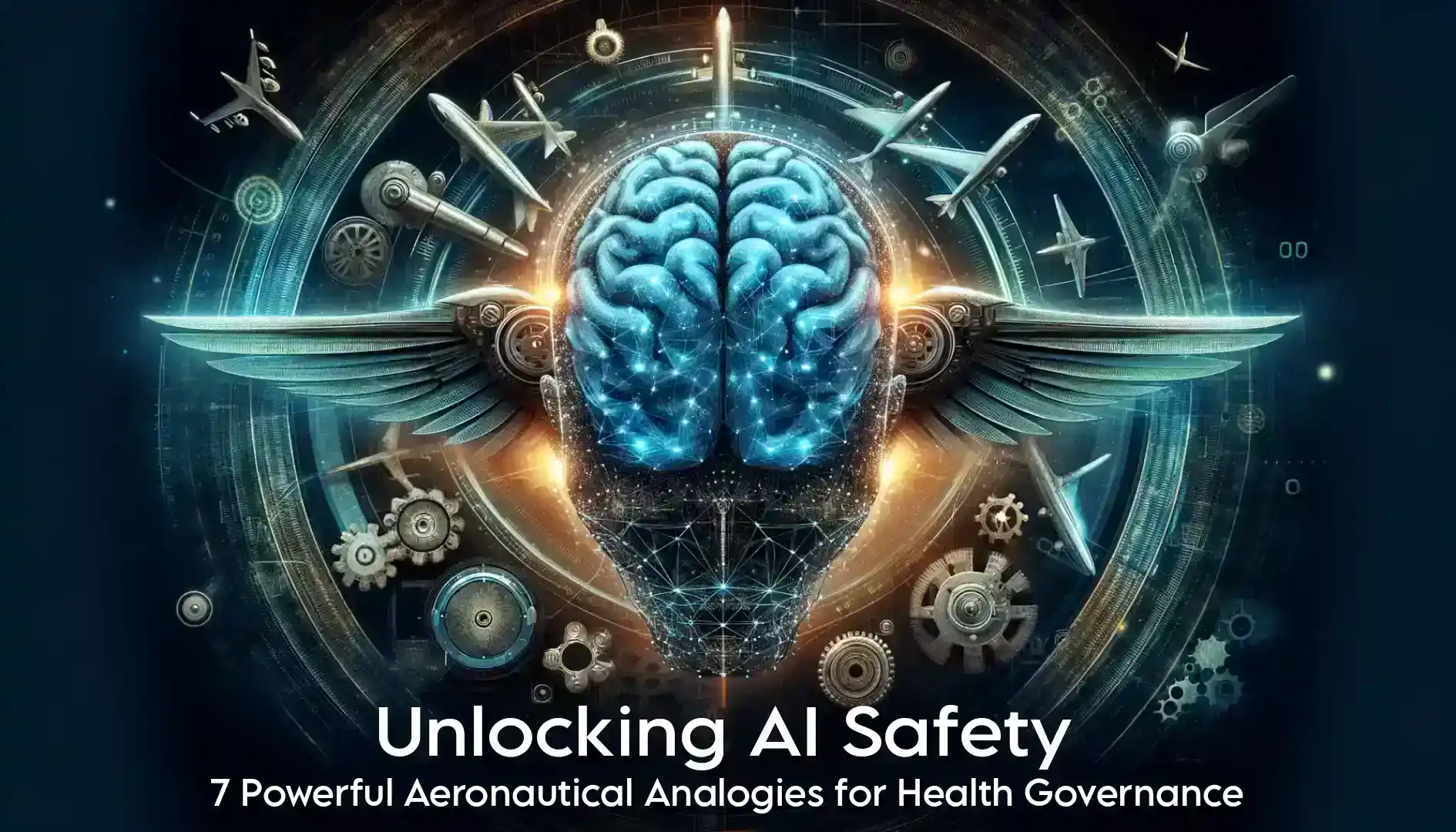Table of Contents
In the swiftly advancing domain of healthcare technology, the imperative to secure the safety of AI applications has become more pressing than ever. This article embarks on a journey into an engaging exploration of aeronautical analogies, illuminating their potent role in fortifying AI within the realm of health governance. Through an examination of seven tangible real-world instances, we aim to dissect the nuanced connections between established aviation standards and the requisite regulatory framework essential for the judicious deployment of artificial intelligence in the healthcare landscape.

As we venture deeper, the intention is to unravel the intricacies of how principles drawn from the aviation industry can be seamlessly integrated into the governance of AI in healthcare. Each analogy serves as a lens through which we examine and draw parallels between the meticulous practices of aviation and the ethical considerations imperative in shaping the trajectory of AI technologies in healthcare. By decoding these powerful analogies, we seek to offer insights that transcend mere metaphorical comparison, providing actionable strategies for stakeholders navigating the complexities of AI integration into the healthcare sector.
Flight Plans and Health Data: Aeronautical Analogies for Governance
AI safety, drawing parallels between the meticulous planning of flight paths and the establishment of data governance is imperative. Just as pilots meticulously plan their routes, considering various factors to ensure a safe journey, data governance serves as the foundational framework for the safe deployment of AI in healthcare.
Flight plans are carefully crafted, taking into account weather conditions, air traffic, and potential obstacles. Similarly, in healthcare AI, structured data governance involves the systematic organization, validation, and management of data. This meticulous approach ensures that the data fueling AI algorithms is accurate, reliable, and free from biases, preventing misinformation that could compromise patient care.
Navigation principles in aviation, focused on optimizing routes for efficiency and safety, find resonance in the structured data governance essential for AI algorithms. By establishing clear pathways for data flow, healthcare organizations can enhance the accuracy and effectiveness of AI applications, ensuring that insights derived from these algorithms contribute positively to patient outcomes.
Redundancy Systems: Ensuring Reliability in AI
In the aviation industry, redundancy systems serve as critical fail-safe measures, ensuring the safety and reliability of aircraft. Drawing a parallel to AI in health governance, the concept of redundancy is integral to establishing fail-safe measures for artificial intelligence applications.
Redundancy in AI involves the implementation of backup systems or algorithms to act as a safety net in the event of primary algorithmic failure. Aeronautical analogies emphasize the importance of these backup mechanisms, much like redundant flight systems that safeguard against potential malfunctions during critical phases of flight.
By adopting a redundancy mindset inspired by aviation standards, AI in health governance can prioritize reliability and minimize the impact of unforeseen glitches. This approach not only aligns with established safety practices but also fosters a resilient framework for the responsible integration of AI into healthcare, ensuring patient safety and instilling confidence in the broader healthcare ecosystem.

Black Box Concept: Transparency in AI Decision-Making
The aviation industry’s black box, a crucial component in aircraft, serves as a recorder of flight data, providing critical insights in case of emergencies. Drawing an analogy from this concept to AI in healthcare, we emphasize the need for transparent decision-making processes, mirroring the black box’s role in ensuring accountability and traceability.
In aviation, the black box captures a comprehensive record of flight parameters, conversations, and system information. Similarly, transparent AI decision-making involves logging and documenting the processes and factors influencing AI-generated outcomes. This transparency not only facilitates post-analysis in case of unexpected results or errors but also fosters a deeper understanding of AI-driven decisions.
For healthcare AI, adopting a black box-like approach means creating systems that log data inputs, algorithms used, and decision outputs. This level of transparency is instrumental in addressing ethical concerns, providing a clear trail of how AI arrived at a specific decision. Stakeholders, including healthcare professionals and patients, can thus comprehend the decision-making process, fostering trust in AI applications.
By integrating these aeronautical Analogies into healthcare AI, we align with the aviation industry’s commitment to safety through transparency. This ensures that AI applications in healthcare operate ethically and responsibly, with decision-making processes that are not only advanced but also comprehensible and accountable to all stakeholders.
Pilot-Autopilot Collaboration: Human-AI Synergy in Medicine
Pilot-autopilot collaboration in aviation exemplifies a harmonious balance between human expertise and technological precision, resulting in safe and efficient flights. Drawing an analogy in the healthcare domain, the integration of AI with human medical professionals mirrors this collaborative synergy, fostering enhanced diagnostic precision and informed treatment strategies.
In aviation, pilots oversee the flight while autopilot systems handle routine tasks and navigate predefined routes. Similarly, AI augments healthcare professionals’ capabilities by processing vast amounts of medical data, identifying patterns, and providing valuable insights. This collaborative approach ensures that human expertise guides critical decision-making processes while AI complements these efforts with computational efficiency.
Real-world instances vividly demonstrate the symbiotic relationship between AI and healthcare professionals. Instances, where AI algorithms assist radiologists in detecting subtle abnormalities in medical images, showcase the potential for improved diagnostic accuracy. The collaboration extends to treatment planning, where AI algorithms can analyze patient data to suggest personalized therapeutic approaches, empowering medical professionals with data-driven insights.
The aeronautical Analogies between pilot-autopilot collaboration and human-AI synergy underscores the importance of a cooperative approach in both aviation and healthcare. By leveraging the strengths of each, we create a dynamic partnership that maximizes efficiency, accuracy, and safety in medical decision-making, aligning with the overarching theme of aeronautical analogies in AI safety.

Pre-flight Checks and Algorithmic Audits
In the aviation industry, pre-flight checks are fundamental safety measures conducted before an aircraft takes off. Analogously, in the realm of AI in healthcare, periodic algorithmic audits serve as essential safeguards. These audits function as the equivalent of pre-flight checks, ensuring the integrity and reliability of AI systems.
Much like a pilot meticulously examines various components of an aircraft before flight, algorithmic audits involve systematic assessments of AI algorithms, data inputs, and overall functionality. These audits are designed to identify any anomalies, irregularities, or potential issues within the AI system. By integrating a continuous monitoring framework, healthcare organizations can proactively detect deviations from expected performance.
The objective is to rectify any identified issues promptly, preventing potential risks or adverse outcomes. This parallels the aviation industry’s commitment to addressing concerns before takeoff to guarantee a safe and smooth journey.
Continuous monitoring and algorithmic audits form a dynamic duo, providing a proactive approach to AI safety in healthcare. These aeronautical analogies underscore the importance of preemptive actions, aligning with the aviation principle of thorough pre-flight checks to ensure a secure and reliable operation throughout the AI system’s deployment in healthcare settings.
Emergency Response in Aviation and AI Incident Handling
In the aviation industry, emergency response protocols are meticulously crafted to ensure swift and effective actions in critical situations. Drawing a parallel to AI incident handling in healthcare, the importance of a robust and well-orchestrated response cannot be overstated.
Just as pilots and air traffic controllers have established procedures to handle emergencies such as engine failures or communication breakdowns, AI systems must have predefined protocols for addressing unexpected issues. Real-world examples underscore the critical nature of these responses, highlighting scenarios where prompt actions in AI incident handling have minimized disruptions in healthcare operations and, more importantly, safeguarded patient outcomes.
Consider a situation where an AI diagnostic tool encounters an unforeseen anomaly, potentially impacting the accuracy of patient diagnoses. Much like aviation professionals who adhere to strict emergency checklists, AI incident handling involves a systematic approach to identify, diagnose, and rectify issues promptly. The parallel lies in the urgency and precision required to mitigate the impact of such incidents, ensuring that healthcare providers can trust and rely on AI technologies without compromising patient care.
By integrating aeronautical analogies into AI incident handling, healthcare organizations can establish a culture of preparedness, enabling them to navigate unforeseen challenges with agility. This not only fosters confidence in the reliability of AI applications but also underscores the commitment to patient safety in the ever-evolving landscape of health technology.

Conclusion
In conclusion, the examination of aeronautical analogies in the context of AI safety for health governance underscores the relevance of principles derived from aviation standards in fortifying the foundations of artificial intelligence in healthcare. The parallels drawn between flight-related practices and AI governance shed light on crucial considerations for navigating the intricate landscape of healthcare technology.
By leveraging the wisdom ingrained in these seven powerful aeronautical analogies, we are not merely drawing abstract connections; instead, we are charting a course toward a future where AI in healthcare stands as a paragon of innovation, safeguarded by principles akin to those ensuring the safety of flights. The implementation of these analogies lays the groundwork for an AI ecosystem that is not only technologically advanced but also prioritizes safety, accountability, and ethical conduct.
As we adopt aeronautical analogies, we recognize that the sky’s principles have tangible applications in healthcare AI, providing a framework that transcends theoretical musings. This strategic fusion of aviation standards with AI governance not only enhances the robustness of healthcare technology but also ensures a trajectory where innovation aligns seamlessly with safety, accountability, and ethical considerations. In essence, the integration of aeronautical analogies into the realm of AI for health governance signifies a deliberate and conscientious effort to elevate the standards of technological progress responsibly and sustainably.